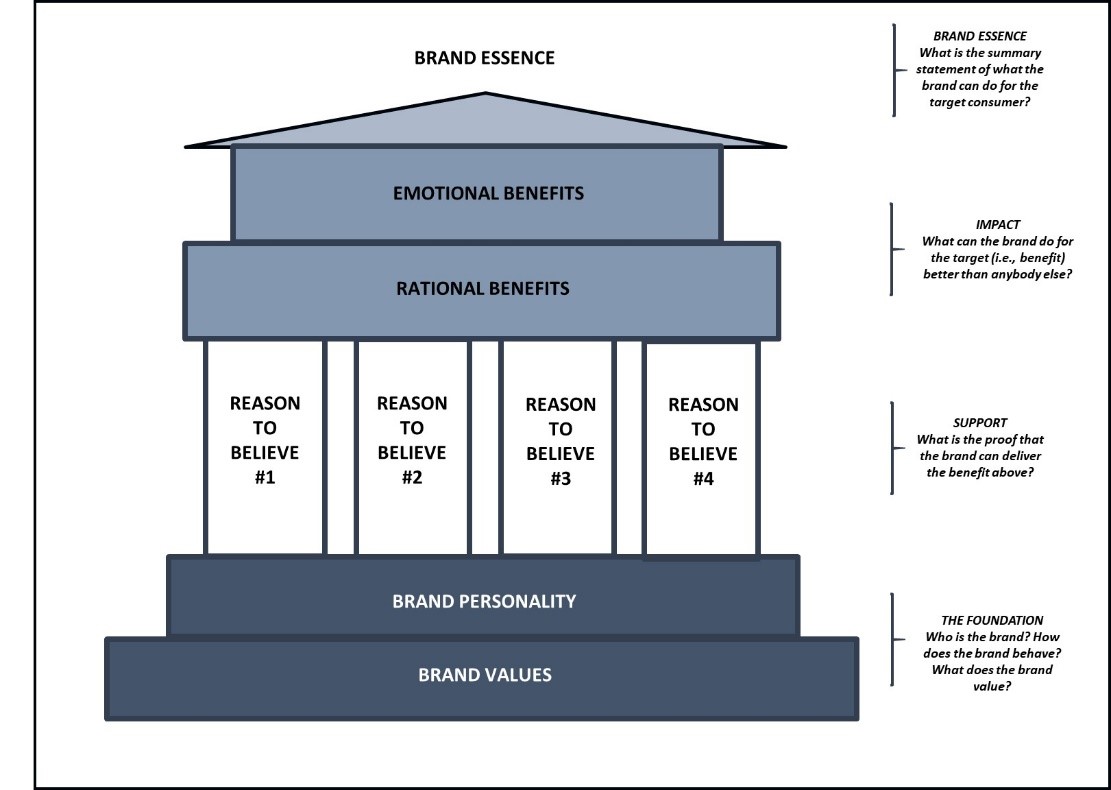

 Article
Article

 To develop and manage a brand effectively, marketers start by defining it with a brand essence statement. In an excerpt from her book Positioning for Advantage, Professor Kim Whitler discusses the blueprint for building a brand from the bottom up, including the foundation, the support, the impact on a consumer and, ultimately, the brand essence.
To develop and manage a brand effectively, marketers start by defining it with a brand essence statement. In an excerpt from her book Positioning for Advantage, Professor Kim Whitler discusses the blueprint for building a brand from the bottom up, including the foundation, the support, the impact on a consumer and, ultimately, the brand essence.

What a brand is exists in the hearts and minds of consumers; to develop and manage a brand effectively, you start by defining the desired brand — i.e., the brand essence statement (BES) — and then implement it consistently and effectively across all brand actions.
The brand is defined by how the consumer perceives it — what they think and how they feel when they experience it, whether through advertisements or shopping in a store. Brand architects (i.e., strategists) create the blueprint (i.e., BES) with its sub-elements detailed so all of the construction workers (i.e., a firm’s employees) can build and deliver the brand according to the strategist’s intention. While each company has its own format with the elements that are most relevant for their circumstances, there are four key BES elements that tend to be common across companies. Those elements are:
While some firms will have more “levels” and attributes that comprise the BES, these four are a good starting point from which to create a brand. Every company tends to have a different way of visualizing the BES, including the Parthenon format, which I will use here.

Source: Kimberly A. Whitler, Positioning for Advantage: Techniques and Strategies to Grow Brand Value (Columbia University Press, 2021)
The brand’s values establish its principles and standards of behavior and define what is important. This is not just a set of words, as it specifically sets the boundaries of behavior.
As an example, at the core of PetSmart’s values is a deep commitment and concern for the well-being of pets.1 Consequently, the founders of PetSmart created PetSmart Charities in 1994 to help ensure “a lifelong, loving home for every pet.”2 PetSmart consistently lives these values by: 1) creating dog and cat adoption centers in nearly every one of PetSmart’s more than 1,600 stores rather than selling cats and dogs (forgoing significant revenue and profit), and 2) partnering with over 3,700 animal welfare groups across North America to help serve pets in need. When I worked at PetSmart, the brand value of deep caring and concern transcended the charitable arm and impacted everything from the recruiting process (how the firm interviewed candidates), to which employees were hired (who demonstrated significant concern for pets), to the training process, store layout, merchandise carried, and so on.
Interestingly, most consumers aren’t aware of how deep the branding process extends because it is more than an ad campaign — it is a set of values the company lives every day.
Most brands have a personality, and this is a critical element of brand design. Ariel in Europe and Tide in the United States (both laundry detergents) are Procter & Gamble brands with similar profiles, targeting a similar segment of the population. Their rational and emotional benefits are similar, but their personalities have been quite different historically. Tide was portrayed more as a close neighborhood friend: warm, caring, and competent when it came to household laundry. Ariel came across a little stuffy and, to some, pompous. A slight difference in the personality of the brand can impact the entire brand image.
Questions to ask: If this brand were a person, who would he or she be? What characteristics would you use to describe the brand (e.g., fun, homebody, adventurous, humble, self-effacing, goofy, serious, masculine, etc.)?
The rational benefit describes the tangible benefit that the product or service provides a consumer. What is the meaningful or relevant benefit that your brand can provide the target consumer better than your competitors? Products and services are purchased primarily to solve a consumer problem, which could be functional or utilitarian, such as wanting a car with better gas mileage or a shampoo that will make hair softer and shinier.
Of note, many brands don’t have, and therefore don’t communicate, a rational benefit. This often happens in categories where there are not tangible, measurable features, such as wine or clothing.
The rational benefit of a brand often connects to a consumer’s brain while the emotional side connects with a consumer’s heart. This benefit is rarely overtly communicated in a commercial. It is often implied in the execution. In a Papa John’s commercial, the chef says: “That’s the kind of pizza I want to feed my family. How about you?” He is essentially suggesting that parents who care about their families will only want to feed them the best. So how might a mom or dad feel? Perhaps like a great parent who provides their family with only the best-quality food.
In a number of categories, there is often a brand that ladders up to an emotional benefit centered on being smart (e.g., Luvs, Buick) or an emotional benefit centered on providing the best care for the family (e.g., Pampers, Subaru).
Between the brand’s foundation and its rational and emotional impact are the pillars of support — the reasons to believe discussed in the previous chapter. Any pizza company can say “better pizza,” but today’s consumers are skeptical. Why should they believe that Papa John’s pizza is better than anybody else’s? Providing this support is absolutely critical. Without demonstrating proof of a product’s ability to deliver the benefit promised, consumers may not believe the brand’s promise.
Trust is at the heart of successful brands. The strongest brands don’t make promises they can’t keep or state benefits they can’t deliver on. If you are creating, evolving or strengthening a brand, one of the most important issues is to ensure that the rational benefit and support are connected, compelling, resonate convincingly with the consumer — and that the product, service or experience can deliver.
The pinnacle of the Parthenon-based BES is the “essence” — a summary of the brand that defines who the strategists want the brand to be in the minds and hearts of the target consumer. This then becomes a summary statement that includes all four aspects to define the brand: 1) who the target consumer is, 2) the frame of reference for the brand, 3) the benefits that the brand provides the consumer, and 4) the support of the promised benefit.
When brand strategists focus on only one element of the BES and ignore the core — the rational benefit and reasons to believe — they leave the brand vulnerable to attack by competitors who focus on what matters most to the greatest number of consumers. And that, unsurprisingly, is usually associated with the problem that they purchase the product to solve.
Excerpted from Positioning for Advantage: Techniques and Strategies to Grow Brand Value by Kimberly A. Whitler, published by Columbia Business School Publishing. Copyright © 2021 Columbia University Press. Used by arrangement with the publisher. All rights reserved.
Whitler is an authority on marketing, with expertise in marketing strategy, brand management, and marketing performance. Her research centers on understanding how a firm’s marketing performance is affected by its C-suite and board.
A prolific writer as well as researcher, Whitler has authored nearly 100 articles related to C-level marketing management challenges and is a contributor for Forbes and CMO.com. Social Media Marketing Magazine named her one of the Top 100 Marketing Professors on Twitter.
Whitler has held leadership roles, including GM and CMO positions, within the consumer packaged goods and retailing industries, including Procter & Gamble, David’s Bridal and PetSmart. She has helped build $1B+ brands, including Tide, Bounce, Downy and Zest.
B.A., Eureka College; MBA, University of Arizona Eller School of Business; M.S., Ph.D., Indiana University Kelley School of Business